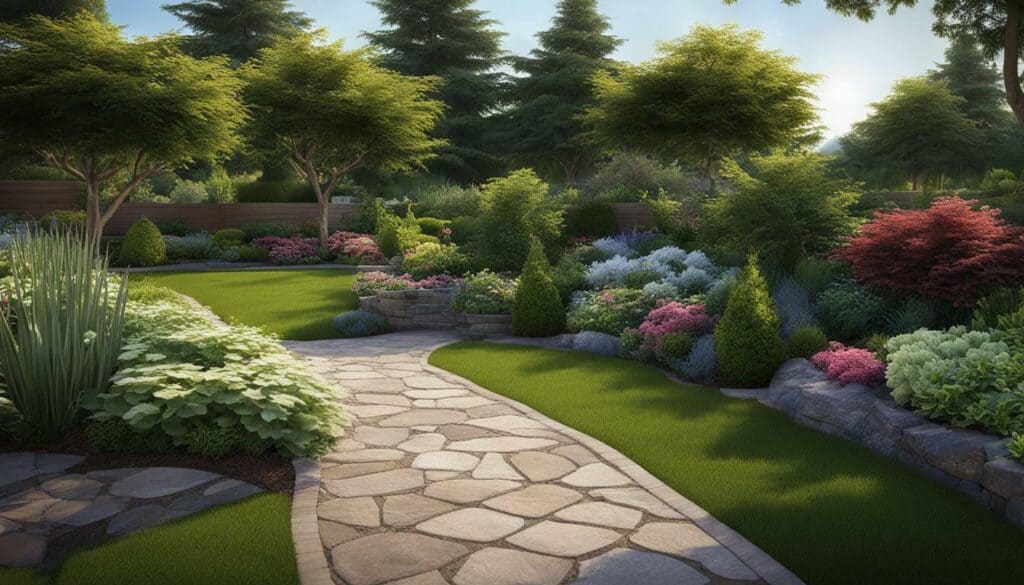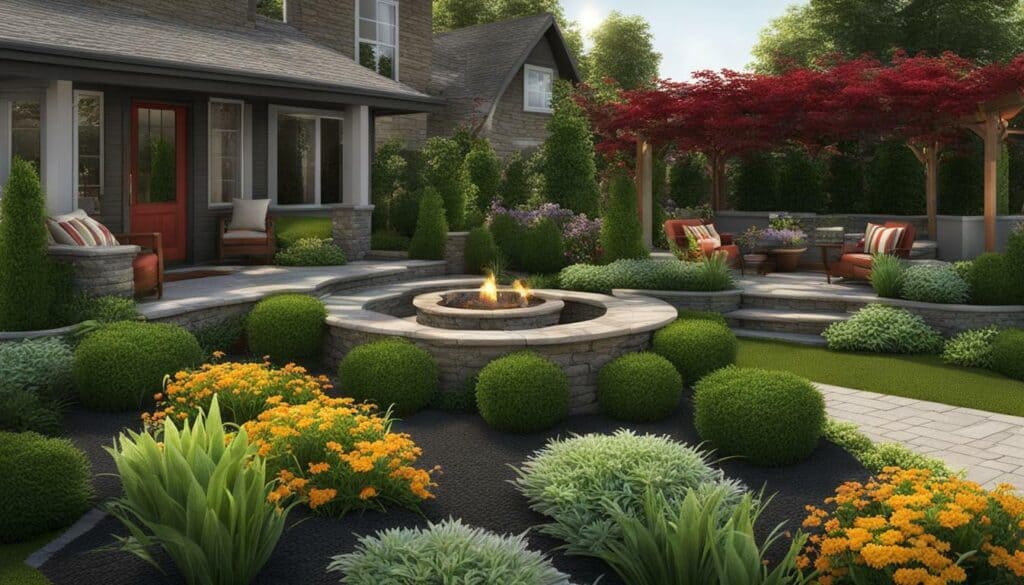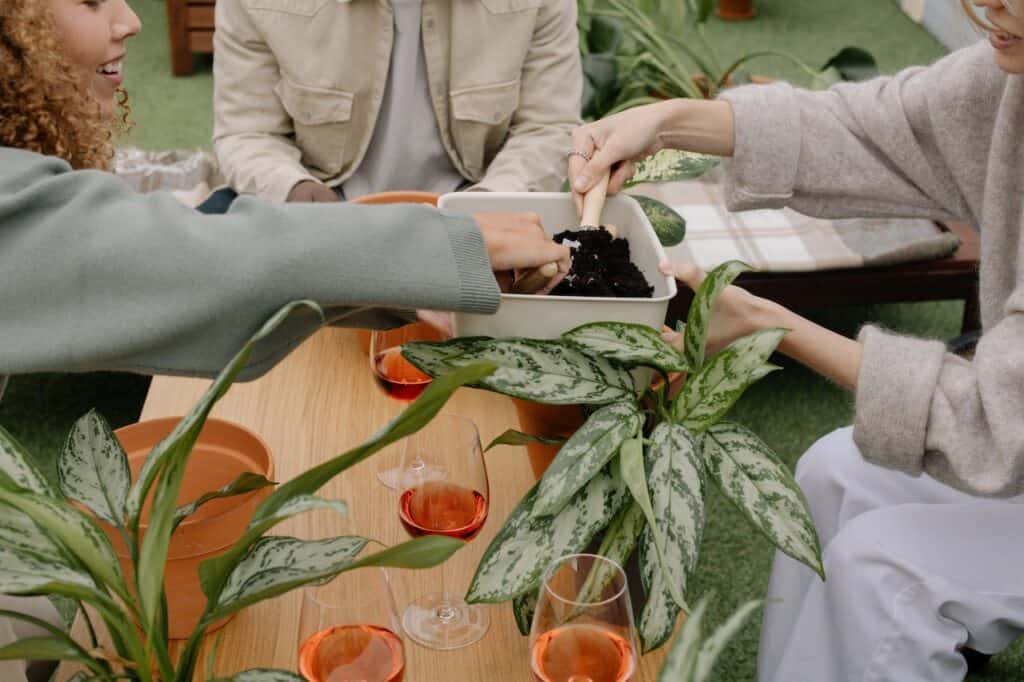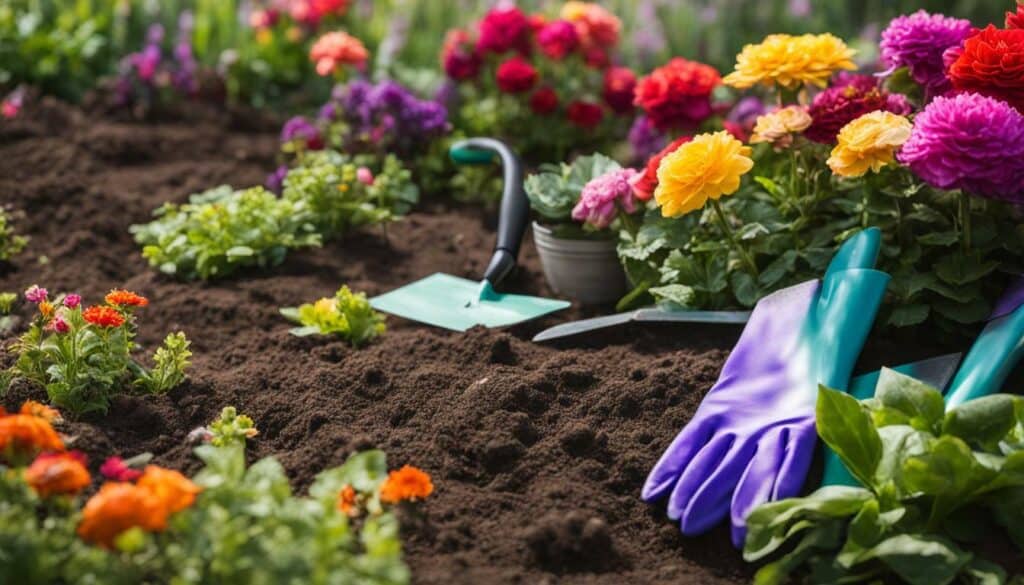Are you tired of your yard not being cozy and want to make changes without spending thousands of dollars? If so, landscaping may be the perfect solution for you. Even if you have no experience with landscaping, this guide will provide you with the tips and tricks you need to create a beautiful outdoor space.
With the right guidance and resources, you can transform your yard into a stunning landscape that leaves a lasting impression. Don’t be intimidated by the process – follow these beginner-friendly landscaping tips and get started on your journey to a gorgeous garden.
Key Takeaways:
- Landscaping can improve the look and value of your home without breaking the bank.
- Start by considering your needs and wants for your yard, such as a play space for kids or a patio for entertaining.
- Be patient and willing to experiment with different elements in your design to achieve the best results.
- A professional landscape designer can help you create the perfect layout and provide recommendations for plants and care tips.
Transform Your Front Lawn into a Luscious Landscape
Transform your front lawn into a luscious landscape with these easy steps. You don’t need to be an expert landscaper to create a beautiful and inviting front yard. By following some beginner landscaping tips and easy landscaping ideas for beginners, you can make your front lawn the envy of the neighborhood.
The first step is to understand the basics of landscaping. Before you dive into any projects, consider the six key design principles that will guide you in creating a visually appealing and cohesive landscape. Once you understand these principles, you can begin to incorporate various design features and elements such as plants, trees, hardscaping, and softscaping. These features will not only enhance the beauty of your front lawn but also make it more functional and enjoyable for you and your family.
If you’re feeling overwhelmed by the process, start small and gradually develop your plan. Make a list of your needs and wants, create rough sketches of your yard, and consider factors such as sun and wind patterns, as well as the needs of your family. Spending time in your landscape before making any changes will help you identify areas where you want to relax or gather with friends and family.
One of the most important aspects of designing your landscape is creating focal points that draw the eyes around the space. By finding a balance between repetition and new elements, you can create a cohesive but not monotonous design. Scale and pacing are also crucial for a pulled-together look. Remember, you don’t have to spend a fortune to create a beautiful front lawn. With the right guidance and resources, you can transform your yard into a luscious landscape that you’ll love.
If you’re unsure where to start, there are various resources available, from beginner-friendly landscaping books to professional landscape designers who can assist you in creating the ideal outdoor space for your home. By investing your own time and creativity, you can raise the value of your home, enhance its curb appeal, and create a beautiful and personalized front lawn.
Remember, creating a beautiful front lawn takes time and effort, but it’s well worth it in the end. With these easy landscaping ideas for beginners and beginner landscaping tips, you can make your front lawn the envy of the neighborhood. So why wait? Start transforming your front lawn into a luscious landscape today.
Master the 6 Key Design Principles
Learn the 6 key design principles to create a visually appealing garden that is both functional and beautiful. These principles are accessible to anyone, regardless of experience or budget. By understanding color theory, utilizing different design features, and incorporating hardscape and softscape elements, you can transform your yard into a stunning oasis.
Color theory is an important aspect of landscape design. Colors can evoke different emotions and moods, and it’s important to use them strategically. Consider the colors of your home and surrounding environment when selecting plants and flowers, and use color to create focal points and areas of visual interest.
In addition to color, incorporating design features such as water features, pathways, and lighting can add dimension and interest to your landscape. These elements can be incorporated in a variety of ways, from DIY projects to professional installation.
When designing your landscape, it’s important to consider the balance of hardscape and softscape elements. Hardscape materials such as stone, brick, and wood can be used for pathways, retaining walls, and other architectural features, while softscape elements include plant materials such as trees, shrubs, and flowers.
Other factors to consider when designing your landscape include privacy, sustainability, and the best time of year for landscaping. Starting small with a focal point and maintaining scale and pacing are also key aspects of successful design. It’s crucial to be open to change and experiment with different elements as you go.
If you’re feeling overwhelmed or unsure about where to start, consider hiring a professional landscape designer. They can provide expertise and guidance in creating the perfect outdoor space, tailored to your unique needs and budget.

Add Design Features and Elements
Discover how to build a patio, hide bulky eyesores, and include different types of plants and trees with these beginner landscaping tips. When it comes to adding design features and elements to your landscape, it’s essential to consider various factors to ensure that your vision comes to life. Whether you’re a beginner or have some experience in landscaping, the key design principles will make your yard beautiful and cohesive.
One crucial aspect to consider when incorporating design features is color theory. By using color theory, you can create visually appealing areas that draw the eyes to specific parts of your yard. Additionally, incorporating various design features into your landscape, such as a water feature or garden sculpture, can add dimension and character.
It’s also important to consider the difference between hardscape and softscape elements. Hardscaping refers to the non-living features of your landscape, such as patios, benches, and walkways, while softscaping involves living elements like plants and trees. Knowing how to balance these elements can help you create a cohesive design and hide bulky eyesores, such as air conditioning units or propane tanks.
When building for privacy or sustainability, you can use design features and elements to maximize your yard’s potential. For example, planting privacy trees or hedges can create a natural barrier between your yard and your neighbor’s, while incorporating a rain garden can help conserve water and reduce erosion.
Remember to focus on scale and pacing when adding design features and elements to your landscape. Starting small with a flower bed or garden statue can help you ease into landscaping and create an aesthetically pleasing layout. Finally, be open to making changes along the way, experimenting with temporary solutions, and seeking professional help when necessary.
By investing your time and effort into incorporating these design features and elements, you’ll create a stunning outdoor space that adds value to your home and reflects your personal style. With over 11 types of plants and trees to include in your landscape and step-by-step instructions for DIY projects, you’ll have all the resources you need to bring your vision to life.

Plan Your Garden with Sun and Wind Patterns in Mind
Plan your garden, consider sun and wind patterns, and spend time in your landscape before making changes. These are important steps to creating a functional and beautiful outdoor space.
When designing your garden, it’s essential to look at the sun and wind patterns in your yard. Direct sunlight and windy areas can have a significant impact on your plants and outdoor activities. Here are some tips to keep in mind:
| Tips for Considering Sun and Wind Patterns |
|---|
| Make a list of your needs and wants for your garden, and roughly sketch out your ideas to visualize the layout. |
| Study the sun and wind patterns in your yard. Take note of areas that receive direct sunlight and areas that are more shaded. Consider how the wind flows through your garden and avoid placing delicate plants or outdoor seating in windy areas. |
| Take the time to observe and experience your yard before making any changes. This will help you identify areas where you want to relax or socialize and determine the best locations for seating and other accessories. |
| It’s okay to start with a small flower bed or a specific area of your garden. Take your time and enjoy the process of creating your landscape. This will prevent you from rushing and making regrettable decisions. |
A focal point is an important element of any garden. A statue, tree, or series of shrubs can draw the eye and create interest throughout the landscape. Remember to balance the size, shape, and color of plants and other elements in your garden to create a sense of cohesion through repetition while introducing new elements to add interest and avoid monotony. Be willing to experiment and make changes if something doesn’t work for you.
By keeping sun and wind patterns in mind while planning and designing your garden, you can create an attractive and functional outdoor haven. Be patient, take your time, and enjoy the process of creating your landscape.

Start Small with a Flower Bed as a Beginner
Start small with a flower bed and find a focal point to draw attention. This is the perfect way for beginners to get started with landscaping. It may seem daunting at first, but with the right mindset, resources, and dedication, anyone can create a beautiful flower bed in their own yard.
Before beginning any landscaping project, it is important to consider certain design principles such as color theory and incorporating different design features. There are many factors to consider, including privacy, sustainability, and timing. Taking all these into account will make for a more cohesive and aesthetically appealing design.
Think of your yard as you would a room in your home. This means considering the layout, placement of plants, and incorporating accessories such as benches, planters, and birdbaths to enhance the overall design. Spending time in the landscape and observing how different areas can be utilized will help in making informed decisions about the design.
Starting small with a flower bed is key for beginners. This allows for a gradual development of a plan and prevents rushing or taking shortcuts that may be regretted later. Finding a focal point or series of focal points is also important. This could be a sculpture, a stunning tree, or a series of shrubs that draw the eye and create a sense of cohesion in the overall design.
Scale and pacing are also important aspects of landscape design. Striking a balance between repetition and new elements helps to create a pulled-together look. It is okay to experiment and make changes as the design progresses. Remember that this is a journey and that there is no right or wrong way to go about it.
Keep in mind that costs can vary depending on the size of the yard, the scope of the plans, and the cost of plants in the area. But on average, it can range from $1,000 for a pro-vetted plan and plants to $10,000 or more.
In conclusion, starting small with a flower bed is a great way for beginners to get into landscaping. By following key design principles, considering location and scale, and being open to change, beginners can create a beautiful and functional landscape. With patience and the willingness to learn and adapt, anyone can transform their yard into a personal oasis.
Focus on Scale and Pacing for a Pulled-Together Look
When it comes to landscaping, focusing on scale and pacing is crucial to achieving a pulled-together look. This involves considering the size and placement of various elements in your yard to create a cohesive and visually appealing space. Here are some key considerations to keep in mind:
- Determining Landscape Needs and Wants: Start by making a list of your needs and wants for your yard. Consider factors such as play spaces for kids, areas for entertaining, and features like fire pits or patios. Rough sketches can help you visualize the placement of these elements.
- Thinking About Location: Study the sun and wind patterns in your yard to determine the best placement for features like patios or outdoor furniture. Consider the time of day and year to ensure comfortable use of these spaces.
- Spending Time in Your Landscape: Take the time to live with your yard before making any changes. By spending more time outdoors, you’ll discover areas and seating arrangements that you may not have initially considered. Opt for flexible patio furniture and accessories that can be used in multiple areas.
- Starting Small: Rather than attempting a complete makeover all at once, start small with a flower bed or a specific area of your yard. Take your time to develop a plan and enjoy the process of gradually transforming your landscape.
- Finding a Focal Point: Incorporate a focal point or a series of focal points in your yard, such as sculptures or beautifully shaped trees. These elements will draw the eye and create visual interest.
- Focusing on Scale and Pacing: Achieving a pulled-together look involves balancing the size, shape, and color of different plants and features in your yard. Incorporate tall plants against buildings or in the back of flower beds, and utilize paths to guide people through the space. Strike a balance between repetition and new elements to create cohesion without monotony.
- Being Open to Change: As you work on your landscape design, be open to making changes if something isn’t working well. Experimentation and editing are essential for creating a design that reflects your style and preferences.
Remember, patience is key when it comes to landscaping. If you’re overwhelmed by the empty space in your yard, consider using temporary solutions like annuals and fast-growing ground covers while you figure out your long-term plans. A professional landscape designer can also be a valuable resource in helping you achieve your desired look.

Embrace Change and Experiment with Temporary Solutions
Be open to change and experiment with temporary solutions. This is one of the most valuable pieces of advice for beginner landscapers. Landscaping is not a one-time project, and it’s important to be flexible as the space evolves. One way to do this is by incorporating temporary solutions, such as using annuals and small perennials, while figuring out the desired design.
Temporary solutions are not only cost-effective, but they also allow for experimentation with different colors and textures. This makes it easier to get a feel for what works well in the space, and it can help you refine your ideas as you go. By embracing change and experimenting with temporary solutions, you can adapt the landscape over time and improve it bit by bit.
It’s also important to consider the needs and wants of the space. Spend time in the landscape to truly understand its potential. Observing the sun and wind patterns can help you determine the best location for different plants and features. You can also use this information to create microclimates that allow for a greater variety of plants.
Starting small is another key to success. Don’t dive headfirst into a large-scale project. Instead, start with a small flower bed or container garden. This will allow you to focus on the details and get a feel for the design elements that work well in the space. You can then expand upon your successes and gradually create a larger landscape.
One more consideration is finding a focal point for your design. This can be a tree, a sculpture, or even a sitting area. Having a focal point helps to create a sense of balance in the space and provides a starting point for the rest of the design.
Finally, maintaining scale and pacing is crucial for a pulled-together look. Keep plants and features proportional to the space, and make sure there is a sense of flow as you move through the landscape. Being open to change and experimenting as you go allows for adaptation and improvement. With the right knowledge and approach, anyone can create a beautiful outdoor space without spending a fortune or hiring a professional designer.

Consider Hiring a Professional Landscape Designer
If you’re tired of not spending enough time in your yard or you feel frustrated by the idea of spending a lot of money to make changes to your backyard, hiring a professional landscape designer might be the solution. Contrary to popular belief, landscaping doesn’t always require a large crew or a huge budget. You can transform your yard into a beautiful space by understanding the basic principles of landscaping and using the right tools and techniques.
A professional landscape designer can guide you through the necessary steps to bring your landscaping dreams to life. They can help you with design principles, using color theory, incorporating various design features, creating privacy or sustainability, and choosing the right plants and trees. Additionally, they can assist in hiding unappealing elements and provide step-by-step instructions for DIY projects.
By investing your own time and working with a professional landscape designer, you can raise the value of your home, enhance its curb appeal, and give your landscape a personal twist. Starting small and focusing on elements like focal points, scale, and pacing can help create a pulled-together look. It’s important to be open to change and experiment as you go.
Hiring a professional landscape designer can be especially beneficial if you’re starting from scratch or if you want expert advice on the ideal layout and plant selection for your specific area. They can assist in creating a design that is beautiful, balanced, and in line with your style. Whether you’re looking to relax, entertain, or simply enhance the look of your garden, a landscape designer can help bring your vision to life.
In conclusion, if you want to transform your yard into a stunning landscape without breaking the bank, consider hiring a professional landscape designer. They can provide guidance, expertise, and the right resources to help you create an oasis in your own backyard. Don’t miss out on the opportunity to improve your home’s value and create a space you’ll love.
Conclusion
In conclusion, by following these beginner-friendly landscaping tips and ideas, you can transform your garden into the oasis you’ve always dreamt about. Landscaping can be both enjoyable and rewarding when approached with the right mindset and tools. Remember to prioritize your needs and wants, study the sun and wind patterns in your yard, spend time in your space before making any decisions, start small with a flower bed, find a focal point, focus on scale and pacing, and be open to change and experimentation.
Whether you’re looking to create a lush backyard paradise or add curb appeal to your front lawn, remember that there are resources and guidance available to help you throughout your landscaping journey. Don’t be afraid to seek the assistance of a professional landscape designer if needed. With a little bit of effort and creativity, you can design a landscape that reflects your personal style and enhances the value of your home. So, what are you waiting for? Now is the perfect time to get started on your landscaping project and transform your outdoor space into a beautiful and functional area for relaxation and entertainment.
FAQ
Q: How can I transform my front lawn into a beautiful landscape?
A: Start by considering the design principles and incorporating design features into your front yard. Plan your garden with sun and wind patterns in mind and start small with a flower bed. Focus on scale and pacing for a pulled-together look, embrace change and experiment with temporary solutions, and consider hiring a professional landscape designer for assistance.
Q: What are the key design principles I should consider?
A: The six key design principles for landscaping beginners are balance, scale, unity, focal points, rhythm, and simplicity. These principles will help you create a visually appealing and cohesive garden design.
Q: How can I add design features to my garden?
A: You can add design features to your garden by incorporating elements such as paths, patios, water features, sculptures, and outdoor seating areas. These design features will enhance the overall appeal and functionality of your landscape.
Q: Why is it important to consider sun and wind patterns when planning a garden?
A: Sun and wind patterns play a crucial role in the health and growth of plants. By understanding and incorporating these patterns into your garden planning, you can optimize the conditions for your plants and create a thriving and well-balanced landscape.
Q: How should I start as a beginner in landscaping?
A: It is recommended to start small with a flower bed. This will allow you to gain experience and confidence in gardening while creating an attractive focal point in your landscape. As you learn and progress, you can gradually expand your gardening endeavors.
Q: How can I achieve a pulled-together look in my landscaping?
A: To achieve a pulled-together look, focus on the scale and pacing of your landscape. Choose plants, design features, and elements that complement each other in terms of size and proportion. This will create a harmonious and visually appealing overall design.
Q: Should I be open to change in my landscaping journey?
A: Yes, being open to change is essential in landscaping. Experiment with temporary solutions, try different plant arrangements, and be willing to make adjustments as you learn and evolve in your gardening skills. Embracing change will lead to a more dynamic and exciting landscape.
Q: Is it necessary to hire a professional landscape designer?
A: Hiring a professional landscape designer can be beneficial, especially for beginners. They have the expertise and knowledge to create a well-designed and functional landscape that suits your preferences and needs. They can also provide guidance and advice throughout your landscaping journey.
What Are Some Easy Steps to Start a Gorgeous Garden in the Ground?
To create a beautiful garden in the ground, follow these easy steps for starting a ground garden. First, choose a suitable location with ample sunlight and good soil drainage. Next, remove any existing weeds or grass, and prepare the soil by loosening it with a garden fork. Then, determine the type of plants or flowers you wish to grow and select seeds or seedlings accordingly. Finally, water your garden regularly and provide necessary care for healthy growth and blooming.
Source Links
- https://www.bhg.com/gardening/landscaping-projects/landscape-basics/landscape-design-for-beginners/
- https://www.amazon.com/Learn-Landscape-Landscaping-Beautiful-Masterpiece-ebook/dp/B09W6C31BN
- https://www.amazon.com/Landscaping-Ideas-Beginners-Complete-Landscape/dp/1803606460
- https://www.amazon.com/Landscaping-Beginners-Step-Step-Beautiful/dp/B08L7QWL14
- https://www.amazon.com/Landscaping-Beginners-Step-Step-Beautiful-ebook/dp/B08LLCHWKJ
- https://books.apple.com/us/audiobook/learn-to-landscape-an-8-step-system-that-every-home/id1625963406
- https://www.amazon.com/Learn-Landscape-Landscaping-Beautiful-Masterpiece/dp/B09W79MXDM
- https://www.amazon.com/Learn-Landscape-Landscaping-Beautiful-Masterpiece/dp/B09WYZGZVH
- https://www.canr.msu.edu/news/principles_of_landscape_design
- https://edis.ifas.ufl.edu/publication/MG086
- https://www.thespruce.com/landscape-design-for-beginners-2130815
- https://www.almanac.com/landscape-design-ideas-and-advice-beginners
- https://www.bhg.com/gardening/landscaping-projects/landscape-basics/landscape-layout-for-beginners/
- https://simplysmartgardening.com/garden-design-how-to/
- https://www.gardendesign.com/how-to/start-a-flower-garden.html
- https://shiplapandshells.com/beginners-guide-to-flower-gardening/
- https://taylorslandscapesupply.com/blogs/videos/seven-tips-for-beginners-in-landscape-design-bluffton-sc-taylors-quality-landscape-supply
- https://issuu.com/primestartmedia/docs/ebm_066/s/30967304
- https://steinborn.com/landscape-design-7-backyard-makeover-tips-for-beginners-growing-green-with-bhgre/
- https://gardening.org/permaculture-101/
- https://www.idealhome.co.uk/garden/garden-ideas/easy-garden-ideas-202397
- https://www.quietvillagelandscaping.com/blog/hiring-landscape-designer/
- https://www.thegardencontinuum.com/blog/bid/22820/7-reasons-to-hire-a-professional-landscape-designer
- https://www.architecturaldigest.com/story/hire-a-landscape-designer-what-you-need-to-know-and-mistakes-to-avoid
- https://gardenmasterz.com/easy-landscaping-ideas-for-beginners/





Leave a Reply